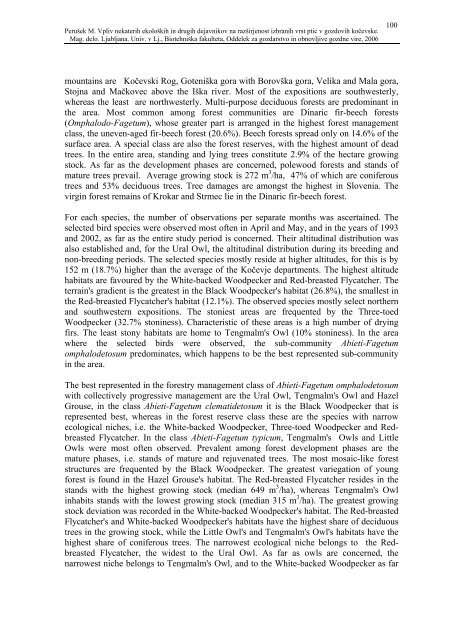polno besedilo - Digitalna knjižnica BF - Univerza v Ljubljani
polno besedilo - Digitalna knjižnica BF - Univerza v Ljubljani
polno besedilo - Digitalna knjižnica BF - Univerza v Ljubljani
Create successful ePaper yourself
Turn your PDF publications into a flip-book with our unique Google optimized e-Paper software.
Perušek M. Vpliv nekaterih ekoloških in drugih dejavnikov na razširjenost izbranih vrst ptic v gozdovih kočevske.<br />
Mag. delo. Ljubljana. Univ. v Lj., Biotehniška fakulteta, Oddelek za gozdarstvo in obnovljive gozdne vire, 2006<br />
mountains are Kočevski Rog, Goteniška gora with Borovška gora, Velika and Mala gora,<br />
Stojna and Mačkovec above the Iška river. Most of the expositions are southwesterly,<br />
whereas the least are northwesterly. Multi-purpose deciduous forests are predominant in<br />
the area. Most common among forest communities are Dinaric fir-beech forests<br />
(Omphalodo-Fagetum), whose greater part is arranged in the highest forest management<br />
class, the uneven-aged fir-beech forest (20.6%). Beech forests spread only on 14.6% of the<br />
surface area. A special class are also the forest reserves, with the highest amount of dead<br />
trees. In the entire area, standing and lying trees constitute 2.9% of the hectare growing<br />
stock. As far as the development phases are concerned, polewood forests and stands of<br />
mature trees prevail. Average growing stock is 272 m 3 /ha, 47% of which are coniferous<br />
trees and 53% deciduous trees. Tree damages are amongst the highest in Slovenia. The<br />
virgin forest remains of Krokar and Strmec lie in the Dinaric fir-beech forest.<br />
For each species, the number of observations per separate months was ascertained. The<br />
selected bird species were observed most often in April and May, and in the years of 1993<br />
and 2002, as far as the entire study period is concerned. Their altitudinal distribution was<br />
also established and, for the Ural Owl, the altitudinal distribution during its breeding and<br />
non-breeding periods. The selected species mostly reside at higher altitudes, for this is by<br />
152 m (18.7%) higher than the average of the Kočevje departments. The highest altitude<br />
habitats are favoured by the White-backed Woodpecker and Red-breasted Flycatcher. The<br />
terrain's gradient is the greatest in the Black Woodpecker's habitat (26.8%), the smallest in<br />
the Red-breasted Flycatcher's habitat (12.1%). The observed species mostly select northern<br />
and southwestern expositions. The stoniest areas are frequented by the Three-toed<br />
Woodpecker (32.7% stoniness). Characteristic of these areas is a high number of drying<br />
firs. The least stony habitats are home to Tengmalm's Owl (10% stoniness). In the area<br />
where the selected birds were observed, the sub-community Abieti-Fagetum<br />
omphalodetosum predominates, which happens to be the best represented sub-community<br />
in the area.<br />
The best represented in the forestry management class of Abieti-Fagetum omphalodetosum<br />
with collectively progressive management are the Ural Owl, Tengmalm's Owl and Hazel<br />
Grouse, in the class Abieti-Fagetum clematidetosum it is the Black Woodpecker that is<br />
represented best, whereas in the forest reserve class these are the species with narrow<br />
ecological niches, i.e. the White-backed Woodpecker, Three-toed Woodpecker and Redbreasted<br />
Flycatcher. In the class Abieti-Fagetum typicum, Tengmalm's Owls and Little<br />
Owls were most often observed. Prevalent among forest development phases are the<br />
mature phases, i.e. stands of mature and rejuvenated trees. The most mosaic-like forest<br />
structures are frequented by the Black Woodpecker. The greatest variegation of young<br />
forest is found in the Hazel Grouse's habitat. The Red-breasted Flycatcher resides in the<br />
stands with the highest growing stock (median 649 m 3 /ha), whereas Tengmalm's Owl<br />
inhabits stands with the lowest growing stock (median 315 m 3 /ha). The greatest growing<br />
stock deviation was recorded in the White-backed Woodpecker's habitat. The Red-breasted<br />
Flycatcher's and White-backed Woodpecker's habitats have the highest share of deciduous<br />
trees in the growing stock, while the Little Owl's and Tengmalm's Owl's habitats have the<br />
highest share of coniferous trees. The narrowest ecological niche belongs to the Redbreasted<br />
Flycatcher, the widest to the Ural Owl. As far as owls are concerned, the<br />
narrowest niche belongs to Tengmalm's Owl, and to the White-backed Woodpecker as far<br />
100
















